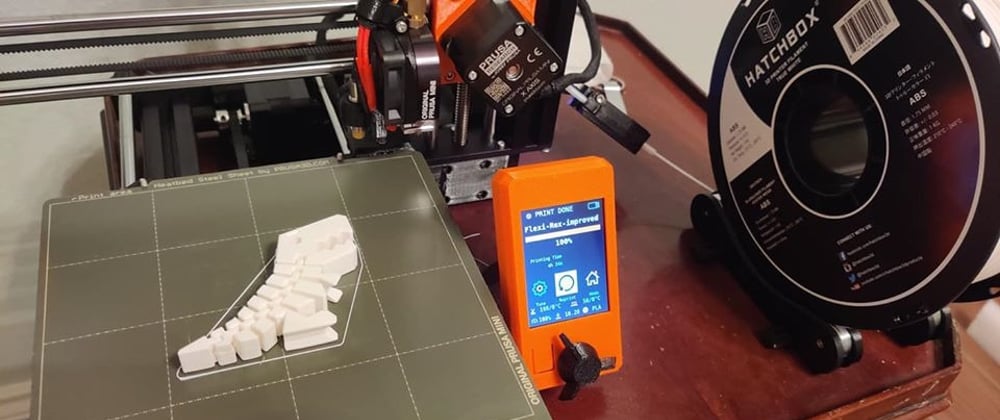As a Christmas/New Year's present, I got myself a 3D printer. I had been toying with the idea of getting one for a while, but I never really jumped to it.
There are many models online, and I had no clue about all of this –I'm a complete noob when related to 3D printing (among other things)– so I checked with a coworker who has one, and he recommended me the brand Prusa. So I got their starter mode: a Prusa Mini.
At this point you may think "If it is your Christmas/New Year's present, how is it that you've had it only for a month?"... and that's a great question. Prusa Mini is a relatively new printer, it has a backorder/waitlist, and coronavirus slowed down production, which ended up with me ordering the printer in January and getting it in June.
The wait was long, and I spent many hours thinking and planning what I could print first: Something cool from Thingiverse? Something that I design myself? Then the printer arrived and suddenly I was out of ideas!
...But my 5-year-old daughter had many. She first helped me assemble the printer, assisted with the calibration and test print, and was quick at suggesting My Little Pony or LOL Surprise searches on Thingiverse 😅
So our first prints were all for kids: cookie cutters, doll accessories, flexi toys (tons of them)... Then a relative saw the prints and said "Hey, could you print something for me?" And that's how we did our first design:
I know it is a really simple thing, but we celebrated it as a big victory. We learned a little of Tinkercad and explore other tools (plus I can do SVG which could be convenient.)
But it was not all easy this month: the printer stopped working because it wasn't pulling the filament in... and that's when I discovered the hobby part of it: 3D printers are not just printing and fun, they require time for learning and maintenance (at least more than what I initially expected).
Luckily for me, a single Allen key was all I needed to disassemble the extruder (a word that I must admit I didn't even know existed before), clean the interior, tighten the screws, et voilà, it worked!
It may sound weird, but 3D printing reminds me a lot of coding: there is a problem, a process, and you get a final result... and there's the feeling of self-fulfillment and achievement, it doesn't matter if it's from fixing the printer or from getting a new model printed.
Next step: combine coding and 3D printing to build something more complex?
As I mentioned above, I'm completely new to 3D printing. I've learned a lot these past few weeks (sometimes the hard way) and I have a lot more to learn. So if you have any advice or recommendation, please share it... I'll definitely need it 😊










Top comments (6)
Awesome! 3D Printing is a great world of interlocking disciplines, all culminating in one of the greatest empowerments to small-scale prototyping/manufacturing, um... ever.
I've had a Wanhao i3 (clone of the Prusa i3) for just over 4 years at this point, and I've learned so much in that time just by using it. Here's some random tips I picked up along the way which may/may not be applicable. Cheers, regardless!
If in doubt, level the bed (luckily the Prusa Mini (and most newer desktop models) comes with auto-levelling; that's a big potential timesaver.
Not all filaments are created equal - though I wouldn't recommend going for the purposefully-overpriced stuff, I personally shy away from the bargain basement filaments. Cheap PLA especially can be a nuisance; I don't know, it just doesn't like to melt well enough or it doesn't cool evenly.
All-metal hotends are awesome - in my case, at least, a Micro Swiss all-metal hotend kit was a great investment. The filament flows smoother out the nozzle and I could print at higher temperatures with stuff like PETG, which I may try in the future.
Try out different nozzle sizes - This one is something I learned earlier this year. The 0.4mm nozzle that came with my printer is OK, but smaller detailed prints look better with a 0.2mm one, and big stuff prints super-fast with a 0.6 or 0.8mm. Although, for most purposes, 0.4mm is a great balance between print quality and print duration.
Sketchup's .STL Export is weird - Exporting to .STL using Google Sketchup (I'm torn at recommending it, honestly. For some things it's awesome; for others it's almost unusable) has almost always given me issues. I use service.netfabb.com, which somehow magically fixes those issues.
GrabCAD is a cool resource - If you can't find something on Thingiverse, especially if it's a technical model, chances are it's on GrabCAD
First-layer skirts are the best in most cases - like the one around that awesome dino up there. I've found that if I need a raft, I'm not doing something right, and brims are a nuisance to pick off the bottom of the part.
If a printed part breaks or is too big to be printed all at once, Elmer's Craft Bond or something like it works wonders for adhering plastic bits, at least in my experience.
Hairspray - at least for PLA (the story is different for ABS etc.) I have found that a 60C glass bed with some hairspray wiped onto it is nearly the best bed adhesion money can buy (that isn't too tight to pull off).
Noctua Fans are Worth It - I had laboured too long near my printer with its horrible cheapy fans whirring with all their might, so I bought a couple of Noctua fans that fit/were the same voltage. ~$25 each, the warranty is great, and for the amount of air they pump around they barely make any noise.
Marlin - Every 3D printer needs firmware to be able to work, and Marlin is one of the best firmwares out there. I got sick of the Wanhao stock firmware which was lacking safety features (and a bunch of games like Space Invaders, which Marlin can be configured to use) so I created a preset configuration for compiling Marlin v2, learning so much along the way about bootloaders, baudrates, Makefiles, and compilation targets. That was fun (though kinda scary as for a couple days I was without firmware or bootloader on my printer's motherboard, which essentially made it a brick)...
UPS - this might only apply in rural areas or areas with... sketchy power, but even a few hundred milliseconds of power interruption was stopping my printer mid-print, until I bought a cheap old APC Uninterruptible Power Supply, and I haven't had any issues like that since.
MOSFET - this one is really only for Wanhao i3 v2.1 owners like myself, but the cheap wiring on the main board started to burn on my printer last year. So, I made a simple modification that added an external power board for the heated bed and extruder, and I haven't had any power problems since.
Wow, that was a lot. Hopefully those were helpful in some way. Good luck I say to anybody getting into the world; it's great fun!
Wow! You've been doing this for a while! I'm barely starting and struggling many times :P :S
The struggle is definitely real! : - }
Anybody that says that budget-friendly 3D printing is consumer-ready with no hiccups whatsoever is likely misinformed. Even the best take a lot of getting used to, but it's definitely getting there. The Prusa Mini looks great, though, and represents even an improvement over my machine.
I think the best way to describe the current state of 3D printing is that it has a fairly low barrier to entry, but the depth of the field and the sheer amount of time and effort it takes to troubleshoot issues or try new things is nearly astounding (not to mention the print times for bigger objects; wow). For the four years I've had my machine, for at least two of them it got barely any use. I got discouraged several times (although in retrospect, over petty things that I was easily able to fix) and it seemed like there were no solutions to the problems I was facing with it.
But then it started to all click. It takes work/trial and error for sure, but oh wow is it rewarding!
Although I honestly think I still have a lot to learn in the field (I've only ever printed with PLA, for instance), I used to think one had to be an expert to be able to use a 3D printer effectively. That is so far from the truth, though. My prints may not be perfect or even pristine, but they work and I'm at a point where I'm happy with them.
If I think up something I need/want that can be made out of plastic (provided I can find a model for it or make one myself), I can hold it in my hand in a matter of hours.
Something that has really inspired me to keep going along the way has been watching YouTubers that like to push 3D printers to their limits. My biggest recommendations in that field are Maker's Muse and Integza.
By all means, welcome to the field!
Also, thanks for your articles here on Dev; I'm really digging the web accessibility series because that's something I highly value as a consideration in my own work. Happy trails! :)
Cool, I'm interested in 3D printing too. What do you think about anisoprint and continuous fiber 3D printing for the manufacturing of optimal composites in general? Is this a future? It would be interesting to use such 3D printers but they are too expensive for personal usage.
If you want to combine code and 3d printing, you could try your hand at openSCAD
Have fun!
Thanks for the suggestion. I'll try it this weekend